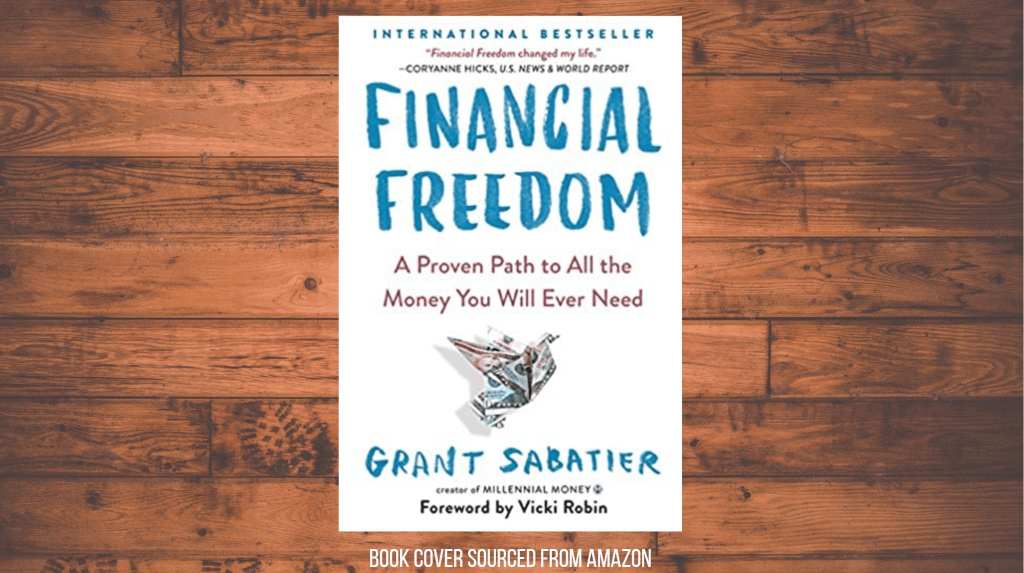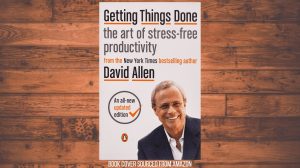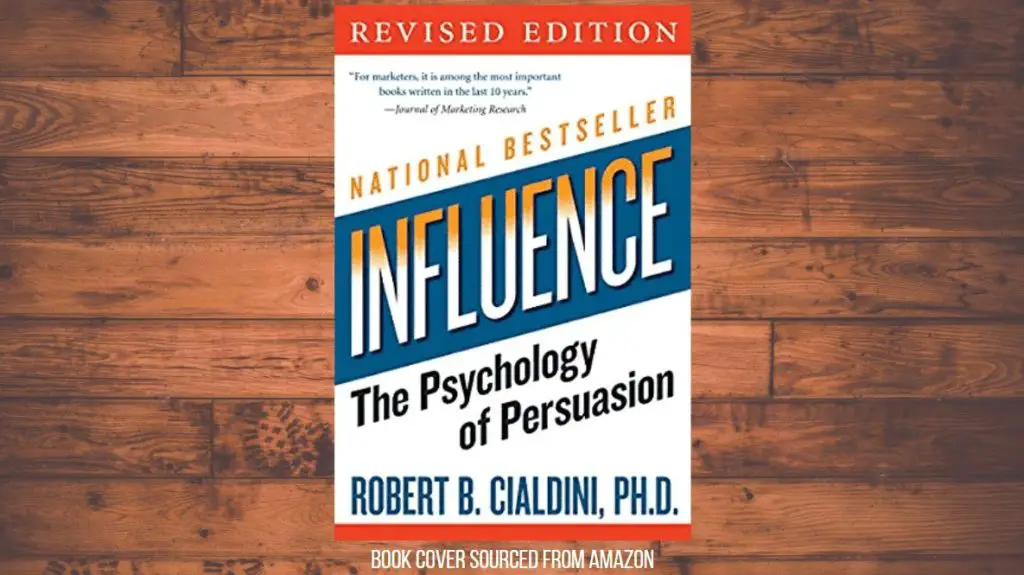This post may contain affiliate links, which means I’ll receive a commission if you purchase through my links, at no extra cost to you. Please read full disclosure for more information.
ABOUT
- Title: Financial Freedom
- Sub-title: A Proven Path to All the Money You Will Ever Need
- Author: Grant Sabatier
- About the author: Grant is the creator of the blog MillennialMoney.com, which has reached over 10 million. He writes about personal finance, investing, entrepreneurship, and mindfulness. Grant is a graduate from the University of Chicago but ditched the corporate world and has created his own success and freedom. He also hosts a podcast titled Financial Freedom.
- Pages: 368
- Published: 2020
- ISBN-10: 052553458X
- Link to book
HIGH-LEVEL SUMMARY

Financial Freedom offers a step-by-step roadmap to make more money in less time so you can do more of what you love. The author, Grant Sabatier, had $2.26 in his bank account in 2010.
He had a revelation, buckled down, learned, and took action that eventually lead to him having a net worth of $1.25 million five years later. On his journey, he found that most advice on money and work was incorrect, incomplete, or outdated.
In his book, he challenges the narratives around 9 to 5’s, credit cards, investing, real estate, saving, budgeting, retirement, and earning more income.
Rather than writing a personal finance book all about saving and budgeting your way to financial freedom, Grant’s advice puts the reader on offense to increase their income in addition to saving and budgeting.
Topics in the book include:
- How you can and should retire early
- How to calculate the amount of money you need to retire and live off of
- Getting clarity on your current finances
- Building wealth quickly
- Looking at money a different way when you make purchases
- Hacking housing, transportation, travel, and food to save
- Optimizing your 9 to 5 to use it as a launching pad to freedom
- Starting a side hustle to earn more
- Investing your money
- Investing using other people’s money
- Strategies to live off your investments for the rest of your life
Grant drove home the point that one’s ability to make money is limitless, but one’s time is not.
The book is written in millennial fashion, with humor and a hint of rebelliousness. I, a millennial, thoroughly enjoyed reading the book and learned a lot as well.
RECOMMENDATION
If you are looking for a fresh perspective on personal finance, this is the book for you.
I’ve read a fair amount of books on personal finance and it gets repetitive after a while. Some things are repeated because the information is timeless, but other things are repeated with outdated information.
Grant Sabatier explains the fundamentals but also looks at things from different angles. This can be eye-opening to readers who are accustomed to the “normal” way of personal finance, work, and investing.
I recommend this book to any individual at any age. The information Financial Freedom touches on can help anyone on their financial journey. Some tips might be more beneficial for readers in their 20s or 30s, but I think readers in their 50s and 60s can even find the book useful.
TOP 15 TAKEAWAYS
** In no particular order*
1. One’s ability to make money is limitless, one’s time is not.
2. There is a limit to how much you can cut back and save, but there is no limit on how much money you can make. It’s never been easier to make money. You just have to open yourself up to opportunity and question norms.
3. Question popular money advice. Most accepted wisdom on money, work, and retirement is incorrect, incomplete, or outdated.
4. The key to fast-tracking financial freedom is to speed up compounding by making and investing as much money as early and frequently as possible.
5. The relationship between time and money is not strictly linear. If you want to make more money, it does not necessarily require more time.
6. Don’t defer your dreams into the future.
7. Your “number” is how much money you will need to achieve your own financial freedom. Calculating and being aware of it will help you plan and execute achieving it.
8. To maximize income earning potential, you need to have an enterprise mindset. An enterprise mindset is thinking like a business to make, save, and grow money. You don’t want to waste money or time and want to take advantage of as many ways to make and save money as possible.
9. Optimize your 9 to 5. Use your full-time job as a foundation and a launching pad for making more money.
10. You want to maximize the four general types of ways to make money: full-time employment, side hustling, entrepreneurship, and investing.
11. When spending money, think of the potential tradeoffs. When you spend, you are losing future dollars that the money could have earned and you are losing time because each purchase will delay your path to financial freedom and require you to work longer.
12. There is a 7-step fast-track investment strategy that is built on 5 key concepts you can directly influence: minimizing risk, minimizing fees, minimizing taxes on your contributions, maximizing returns, and minimizing taxes on your withdrawals.
13. Real estate is a great way to diversify your investment portfolio and risk. With real estate, you can earn returns on potential rental income, appreciation in the property’s value, and through tax benefits. In addition, you don’t have to put all your own money into the investment. You can use the money of others through a mortgage to amplify your cash return (see cash-on-cash return).
14. Once you reach financial freedom and are ready to retire, thought will need to be put into developing the right withdrawal strategy to ensure your money will last as long as possible.
15. Just get started. Starting is more important than making the perfect decision. No matter how many books you read or classes you take, there is no better way to learn than actually taking action.
WHAT I LIKED

Challenges the norms around money advice
Grant brings a fresh perspective to money and challenges many of the norms related to money and work. He mentions how one of the hardest things to do on the path to fast-tracking financial freedom is to look at the world differently.
I tend to agree with Grant. I believe it’s important to keep an open mind about everything and see everything as it is, not as you have been conditioned to think.
One problem with the traditional path to retirement is that the most valuable years of your life are spent working.
In 2022, things are different and we have access to tools and resources that weren’t even available a decade ago. However, most of the popular books on personal finance were written longer than 10 years ago and information can become outdated.
Here are some of the common norms that Grant questioned in the book and provided insight and solutions to:
- The way to retire is to work a 9 to 5, set aside a portion of your income to retirement accounts, and in 40+ years you will have enough money to retire and begin enjoying life
- Retirement only happens in your 60s
- Earning more money requires more time and work
- Managing money requires a hefty amount of knowledge, time, and effort
- Credit cards are bad
- Becoming an entrepreneur takes large amounts of capital and investment
- Being smart with your money means cutting back spending on everything and sacrificing things you enjoy
- To invest wisely and achieve returns, you need to have the pros manage your money by using a financial advisor or investing in funds with “skilled” managers
- Investing in real estate takes hundreds of thousands of dollars and a 20% down payment
Offers a practical roadmap
Financial Freedom is filled with actionable steps you can take to improve your financial situation. The advice is practical and provides you with a road map to take matters into your own hands in a sustainable and achievable way.
Some of the advice in the book requires more effort than others, but even the ones requiring more effort, such as real estate investing, require a lot less than most people think.
For the books that I read, I keep a separate document of notes with important information and action items that can be useful to me. My notes on Financial Freedom were so filled you would think that I copy and pasted the entire book in there.
This is a testament to how valuable the information is.
Digestible book with divisions of chapters and sub-headings
The design of the book makes the information easy to digest and less intimidating to read.
This book is broken out into 14 chapters with well-categorized information. Within each chapter, there are frequent sub-headings that let the reader know what the next section is about. This chunking of topics makes the entire book more digestible.
Each individual chunk of the book was easy to read. After I read one, I read another. And another. Before I knew it, I read 50 pages in one sitting.
So overall, the structure of the book made for an easy read.
Use of examples, math, and tables
The book is filled with examples of actual individuals that have implemented the information in the book and have seen results. I assume the stories are true and they are reassuring for the possibilities of what can happen if you take action.
To help make points clearer, the math behind the calculations are given in the book and the effects of the math are shown in tables.
For example, there is a table in the book that shows you how many years it will take you to reach financial independence based on your annual after-tax income and your annual expenses.
The tables in the book help you understand the concepts and impacts in a visual way.
Financial concepts well-explained
Vocabulary and concepts within finance can be confusing at times, especially if the material is new to you.
I thought everything in the book was explained in simple terms, but not too simple where important information was left out.
It’s a tough line to walk and I think the author did a great job.
The material is not overwhelming and doesn’t get too far into the weeds that you lose track of the bigger picture. When you read this book, you’ll learn enough to be able to have conversations about the concepts, strategies, and investment instruments presented.
The author is living proof of what he teaches
I knew about the author, Grant Sabatier, prior to reading his book. I knew about him from his blog, MillennialMoney.com. He laid out his story in the book and it is inspiring for someone who is also trying to reach financial freedom and escape the 9 to 5 life.
He practices what he preaches in his book and he has the results to show for it.
Because of his credibility, I have more faith in the advice that he gives. I appreciate wisdom shared from people like Grant.
He went the normal route, got a college a degree, and worked for a company. This is what we are taught to aim for.
He then questioned the norms and carved his own path to achieve financial freedom.
WHAT I DIDN’T LIKE
Financial Freedom provides information that is deeper than surface-level, but still requires a lot of research by the reader, and that’s okay. This is not a knock on the book itself.
With everything listed in this book, it would take hundreds of additional pages to walk someone through everything. An entire book can be written on saving, budgeting, investing, side-hustles, real estate, and mindset.
The book is meant to provide awareness and a practical roadmap for readers looking to achieve financial freedom.
The book still does an amazing job of giving enough detail and explanation for readers to work with.
This is just my own selfish desire to want even more from the book because I enjoyed the way the author wrote.
BENEFITS TO YOUR LIFE AND CAREER

If you have made it to this section of the blog post, you can probably see all the benefits the information in this book can have for your life and career.
Money is the biggest cause of stress for people and that stress follows you while you are in school, at work, and in your day-to-day life.
Personal finance is daunting to learn about and people have the tendency to put it off until later. It isn’t until their late 30s/early 40s that people begin to realize they should have been saving, budgeting, and investing earlier.
Financial Freedom is a value-packed book that can take your financial situation to the level you want if you take action.
As a person who studied finance/business, I still found things that were new to me and was shown things from a different angle than I wasn’t used to.
This book brings awareness to numerous topics, the effects of the numbers, and options you can take to increase your income, save, budget, and invest. Additionally, the book gives you a plan and steps to take to begin implementing it.
I’d say that everything written in the book can provide some sort of value to your life and career.
10 ACTIONS YOU SHOULD TAKE
1. Start questioning things more to think about their applicability to today’s world and your personal situation and goals.
2. Figure out where you currently are and where you want to go. Work backward from your end goal to figure out what you can do each day to achieve your goal.
3. When you want to buy something somewhat pricey, wait 30, 60, or 90 days. The impulse will subside and you will be able to make the purchase logically.
4. Calculate your “number” that the book mentions to determine how much you need to have to live off of forever. Then break that number down into savings/earnings goals you can adhere to.
5. Identify the debt that you have. Pay off debt with high interest rates. For debt with low-interest rates, weigh the pros and cons of paying off that debt or using that money to invest and potentially earn a return that is a higher rate than your interest payment. If your interest rate is 4% on your debt and you can earn 7% in the stock market, putting your money in stocks could make more sense.
6. Sign up for a 401(k) at work and invest enough to get the employer match because it is free money.
7. Do some research and exploring to find ways to make money through the 4 types mentioned in the book (full-time employment, side hustling, entrepreneurship, and investing).
8. Treat yourself like a business and develop the enterprise mindset. Maximize your earnings, cut expenses, optimize fees/prices, minimize taxes, and anything else to increase the size of your “profit.”
9. When making minor purchases, start asking yourself, “How happy will this purchase make me?” If the answer is “not much” then avoid the purchase.
10. Read the Seven-Step Fast-Track Investment Strategy thoroughly and use it as a manual to implement the tips given.
RESOURCES
Financial Freedom can be found on Amazon at this link here if you are interested in reading.



